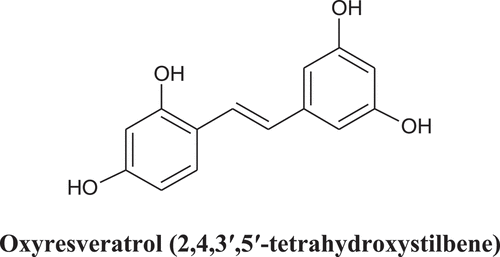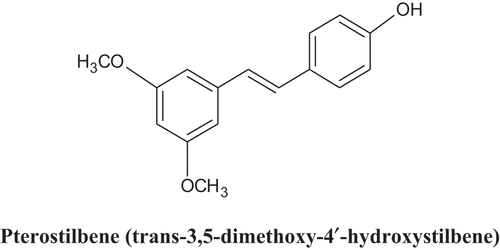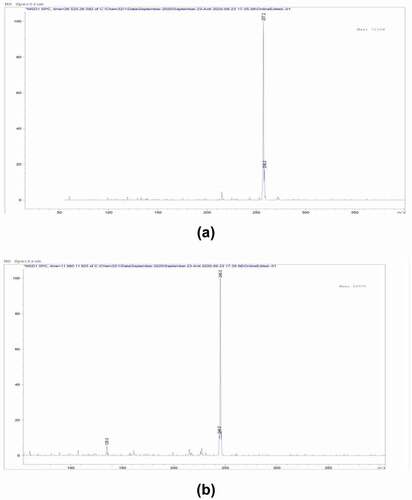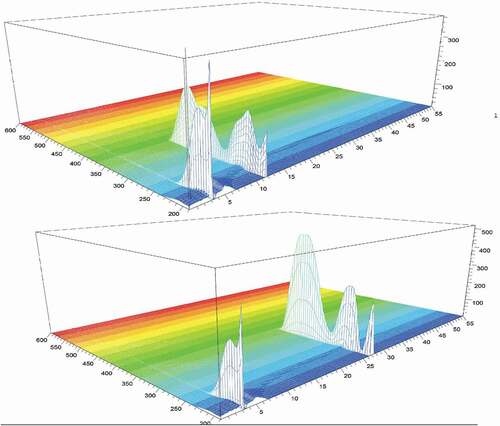Abstract
Glycation is a non-enzymatic biochemical reaction between reducing sugars and amino acids, causing the crosslinking and rearrangement of glycated proteins, leading to irreversible formation of Advanced Glycation End products (AGEs). Glycation is an activity that occurred both endogenously in our body and exposed to it through our diet as well, which contributed to the pool of AGEs and their pathology. AGEs played important role in various health conditions including and not limited to, hyperglycemia, inflammation, Alzheimer’s disease, cardiovascular health and, ageing itself. While the formation of AGEs is irreversible, its formation can be inhibited or slowed down by natural products, which have anti-glycation activity. In this study, we explored the antiglycation activity of commercial herbal extracts of Artocarpus lakoocha and Pterocarpus marsupium using a competitive fluorescence assay. Both Artocarpus lakoocha and Pterocarpus marsupium extracts show highest anti-glycation activity (84.6–100%) after background correction, in a range of 10 to 100 mg/ml.
PUBLIC INTEREST STATEMENT
As science on ageing started unfolding various players involved in aging process, one finds the AGE (Advanced Glycation End) products formed in our body hold important key to our understanding on aging. AGE products are formed as a result of the process of glycation, a non-enzymatic reaction between sugars and amino acids, which occurs both externally and internally in our body and over time accumulate in our body and considered as a contributing factor for several chronic health conditions. Our lifestyle choices and dietary habits also expose us to factors accelerating this glycation process. In this research article, we attempt to evaluate the antiglycation properties using a fluorescence method of polyphenolic rich dietary supplement ingredients/nutrients which can inhibit or slow down the process of glycation and promote healthy aging process.
1. Introduction
Excessive exposure to oxidative stress by reactive oxygen species (ROS), inflammation and advanced glycation end products (AGEs) is a precursor to many chronic lifestyle-related diseases such as diabetes, cancer, cardiovascular and degenerative disorders. While oxidative stress and inflammation have been studied in-depth for their role in the development of the above health conditions, the role of AGEs on such chronic health conditions as well as the aging process itself has caught the attention of both researchers and nutritionists in recent years (Prasad et al., Citation2019).
Glycation occurred not only in animal or human body but also in nature. A good example of this interaction in nature can be found in Maillard reaction (Tamanna & Mahmood, Citation2015). Glycation is a non-enzymatic biochemical reaction between adehydic or keto group of reducing sugars and amino group of amino acids of proteins, nucleic acids, leading to formation of schiff’s base, which undergoes Amadori rearrangements to form more stable glycosylamine products also known as Amadori products. These Amadori products further undergo dehydration and rearrangements to form more reactive intermediate compounds such as methylglyoxal, glyoxal, and deoxyglucosones. These intermediates reacted with free amino group of biological protein molecules at faster rate than initial reducing sugars, thereby, propagating the reaction. Finally, the crosslinking and rearrangements of these glycated proteins lead to the formation of AGEs (Odjakova et al., Citation2012) that are irreversible.
AGEs do not just form inside the body endogenously, but we can also be exposed to these in our food, as they are formed during the food processing, heating or storage (Uribarri et al., Citation2010). These dietary AGEs are also known to add up to the pool of endogenously formed AGEs and thus contributing to their pathology. The significance of dietary AGEs can be observed from notable increase in circulating AGEs levels in patients with renal failure, and non-diabetic subjects consuming high AGEs diet even for a short duration (Uribarri et al., Citation2003).
Body conditions, such as hyperglycemia—where there is excess metabolic reducing sugar, facilitate the formation of AGE in both Type I and Type II diabetic patients, contributing to the various complications in diabetic subjects (Januszewski et al., Citation2003). While the role of AGEs is well studied in the T2DM (Type 2 Diabetes mellitus), the involvement of AGEs in aging and neurodegenerative diseases such as Alzheimer’s disease (Takeuchi et al., Citation2004) has further increased the interest in management of these diseases by reducing the dietary as well as endogenous formation of AGEs and their accumulation. Some of the strategies to prevent accumulation of AGEs in the body are to modify diet by reducing the intake of food which is high in AGEs and include nutrient supplements, which potentiate body’s defense to fight the oxidative stress and AGEs (Koch & Deo, Citation2016; Uribarri et al., Citation2010). Drugs, for example, metformin, aminoguanidine and angiotensin receptor blockers, can prevent the formation of AGEs. However, these drugs have their own side effects, hence there is a great interest in natural products with potential anti-glycation effects (Younus & Anwar, Citation2016).
While AGEs were first recognized as compounds formed from exposure of proteins to the reducing sugars in diabetes, the formation and accumulation of AGEs can also take place in other diseases as ageing itself played an important role in their manifestation. One of the mechanisms by which AGEs induce inflammation and other chronic diseases is by the production of reactive oxygen species (ROS) (Basta et al., Citation2005). This induction of reactive oxygen-free radicals occurred via receptor-mediated mechanisms. The receptors also known as RAGE (Receptors of AGEs) which can be mediated the activation of NFkB (Nuclear Factor kappa-light-chain-enhancer of activated B cells) (Kowluru & Chan, Citation2007), a cytoplasmic protein that regulated inflammation.
Antiglycation is the prevention of AGEs from generating. It has been shown that hampering the glycation reaction may result in reduced inflammatory responses and in turn can be useful in reducing aging and onset of many disease (Yeh et al., Citation2017) Many natural products obtained from plants such as polyphenols have antiglycation potential (Yeh et al., Citation2017). The antiglycation activity of these nutrients is partly derived from their antioxidant activity by which it can be prevented the onslaught of the ROS production as a result of AGEs formation.
Artocarpus lakoocha Roxb. also commonly known as Monkey Jack, is a deciduous tree belonging to Moraceae family and is native to South East Asian peninsula (Panday et al., Citation1985). Several parts of this tree are traditionally used in folklore medicine and are known to have antibacterial, purgative with anti-viral activity. It is also applied on skin for boils, cracked skins and common skin problems like acne (Jagtap & Bapat, Citation2010; Kumar et al., Citation2010). The heartwood of this tree is rich source for a trans- stilbenoid polyphenol—oxyresveratrol (Maneechai et al., Citation2009).
Oxyresveratrol (2,4,3′,5′-tetrahydroxystilbene) () is a hydroxylated derivative of stilbene structure with C6-C2-C6 backbone. Oxyresveratrol has also been studied for its antioxidant potential, tyrosinase inhibitory activity and antimicrobial activity (Joung et al., Citation2016; Kim et al., Citation2002). However, one activity which is of great interest, is its antiglycation potential (Povichit et al., Citation2010).
Pterocarpus marsupium, known as Vijayasar (in Hindi), Malabar or Indian kino tree, is a deciduous tree belonging to leguminoceae family. It is native to the Indian subcontinent and has been long used as a medicinal herb in the traditional medicine system of India—Ayurveda (Maurya et al., Citation2004). Heart wood has antihelminthic, rejuvenating, anti-inflammatory and antidiabetic properties (Gupta & Gupta, Citation2009; Hari & Gaikwad, Citation2011). The heart wood contained pterostibene, a well-known analog of resveratrol, and has been recognized for its medicinal properties (Liu et al., Citation2020).
Pterostilbene (Trans-3,5-dimethoxy-4′-hydroxystilbene) () is 3,5-dimethoxy analogue at A—phenyl ring of resveratrol. Pharmacologically, pterostilbene is similar to resveratrol, however, it is more bioavailable than resveratrol due to its lipophilic nature (Tsai et al., Citation2017). Pterostilbene’s potential benefits in prevention and treatment of various ailments have been attributed to its antioxidant and anti-inflammatory properties, leading to the management of cognitive health, as well as metabolic and cardiovascular disorders (McCormack & McFadden, Citation2013).
In this study was to describe the antiglycation activity using an AGE Competitive Fluorescence Assay for commercially available extracts of Artonox® (A. lakoocha wood standardized to oxyreveratrol 95%), and Silbinol® (P. marsupium heart wood extract, standardized to 90% pterostilbene) to evaluate their potential application of as antiglycation ingredients in dietary supplements, functional foods, nutraceuticals and cosmetics. Also, we confirmed the presence of oxyresveratrol and pterostilbene and their assay in the above extracts using HPLC-MS analysis.
2. Materials and methods
2.1. Materials
Silbinol® (Pterocarpus marsupium heart wood extract standardized to 90% Pterostilbene) and Artonox® (Artocarpus lakoocha bark extract standardized to 95% Oxyresveratrol) are available in the health supplement market in USA as dietary supplements.
2.2. HPLC–MS analysis
Separation of peaks of oxyresveratrol and pterostilbene in their respective extracts (Artonox and Silbinol) was achieved using single High Performance Liquid Chromatography (HPLC) method. Retention times for oxyresveratrol and pterostilbene in this method was confirmed by reference standards of the compounds. Reference standards of oxyresveratrol and pterostilbene were dissolved separately in methanol (20 mg/100 ml) to make stock solutions. The stock solutions was further diluted with the diluent (acetonitrile: water = 50:50) to achieve final concentration of 0.02 mg/ml. HPLC separation was achieved on a Kinetex C-18 column (250 x 4.6 mm, 5 µ, 4.6 mm). 20 µl of mixture of reference standards was injected in HPLC and separated using 0.1% formic acid (solvent A) and acetonitrile:water (95:5) (solvent B) as mobile phase with flow rate of 0.7 ml/min. The separation was achieved with a gradient using 85% of mobile phase A at time 0 min and gradually changed to 30% in 30 min and 5% of mobile phase A in next 10 min. In post analysis, column was washed with 95% acetonitrile. The analysis was performed on 330 nm using photodiode array detector.
The sample of A. lakoocha extract containing oxyresveratrol and P. marsupium extract containing Pterostilbene were prepared using the method described above and injected individually in HPLC-MS (High Pressure Liquid Chromatography—coupled with Mass Spectroscopy (Agilent Technology USA, 6120 LCMS SQ & 1260 Infinity HPLC system). The peak of oxyresveratrol and pterostilbene in their respective extracts were identified by comparing retention time (Rt) with their respective reference standards. The mass spectrum were recorded for peaks of oxyresveratrol and Pterostilbene. MS detector parameters are as follows: drying gas flow was 12 l/min, nebulizer pressure was 45 psi, drying gas temperature was 300°C and capillary voltage was 3500 V.
2.3. Determination of antiglycation activity
Antiglycation activity was determined using a combination of Bovine Serum Albumin (BSA) Fraction V (Research Products International, country origin), D-(+)-Glucose (≥99.5%, Sigma) (Perera et al., Citation2013). In all experiments, the final reaction volume was 1.0 ml for each extract at each concentration and at each time point and carried out in 1.5 ml eppendorf tubes. 500 μl of BSA (1 mg/ml concentration in phosphate buffered saline) was incubated at 60°C with 400 μl of glucose (1.25 M in DI water) and 100 μl of Artocarpus extract and Pterocarpus marsupium extract (0, 1.0, 10.0, and 100.0 mg/ml in acetone). Placebos lacking glucose were prepared and incubated at 60°C and contained 500 µl of BSA (1 mg/ml), 400 µl of DI H2O, and 100 µl of A. lakoocha extract and P. marsupium extract separately (0, 1.0, 10.0, and 100.0 mg/ml in acetone). All concentrations and time points were analyzed simultaneously with the same products, concentrations, and time points in the absence of glucose. The amount of glycated BSA (AGE-BSA µg/ml) is determined using AGE competitive fluorescence. All treatments including the placebos were analyzed in triplicate in the fluorescence plate assay using a SpectraMax M3 fluorescent plate reader. The excitation and emission wavelengths used were 370 and 440 nm, respectively.
3. Results and discussion
Occurrence of pterostilbene and oxyresveratrol in Silbinol® and Artonox:
The peak of Pterostilbene in P. marsupium extract (Silbinol) eluted at 26.51 min () while the peak of Oxyresveratrol was eluting at 11.66 min (). The assay of the Pterostilbene in P marsupium extract was found to be 95.8% and assay of Oxyresveratrol was found to be 95.1% in A. lakoocha extract.
Figure 3. (a) HPLC chromatogram of Pterocarpus marsupium extract (Silbinol) with pterostilbene peak (Rt 26.51 min). (b) HPLC chromatogram of Artocarpus lakoocha extract (Artonox) with oxyresveratrol peak (Rt 11.66 min)
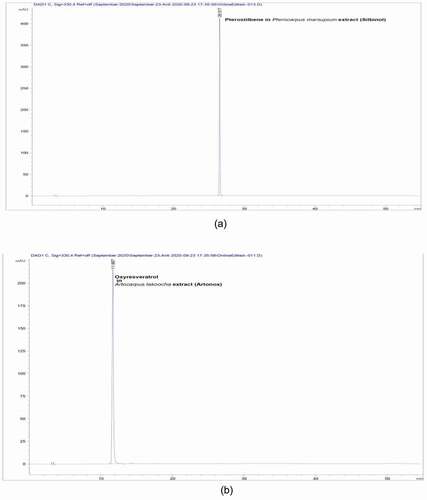
The mass of major peak in P. marsuium extract (Silbinol) at positive ionization mode showed value [M + H]+ 257.2 (), while the mass of major peak in A. lookcha extract (Artonox) showed [M + H]+ 245.0 ().
4. Antiglycation activity
Both pterostilbene and oxyresveratrol’s linking of C = C double bond has Trans conformation and allow the formation of a conjugated system throughout the molecule which imparts natural fluorescence to the molecule. When determining the amount of glycated BSA using AGE competitive florescence methods, a correction factor must be applied to account for the natural fluorescence of polyphenols such as oxyresveratrol and pterostilbene. A. lakoocha extract (Artonox) and P. marsupium extract (Silbinol) are control solutions, lacking glucose, were prepared and incubated under the same conditions as the glucose containing treatments. The natural background fluorescence of the both extracts were subtracted from the respective glycated AGE-BSA to give a background-adjusted results ().
Figure 5. Corrected fluorescence of Artocarpus (0, 1, 10, and 100 mg/ml) in AGE-BSA (-glucose) after 0, 24, 48, 96, 168, and 192 hours of incubation at 60°C
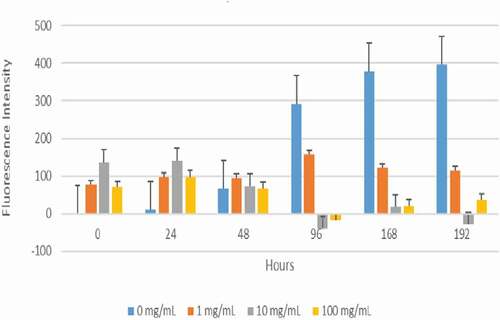
Figure 6. Corrected fluorescence of perocarpus extract (0, 1, 10, and 100 mg/ml) in AGE-BSA (-glucose) after 0, 24, 48, 96, 168, and 192 h of incubation at 60°C
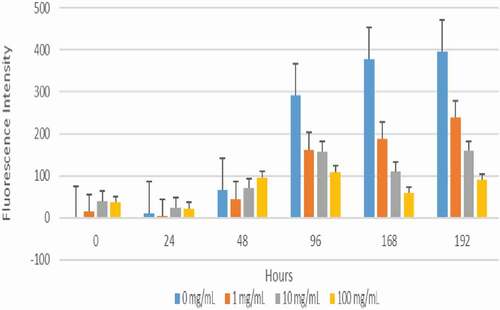
AGE competitive fluorescence assay show that both A. lakoocha extract (Artonox) and P. marsupium extract (Silbinol) inhibited AGE-BSA production in a dose dependent manner after 96, 168 and 192 hours of incubation. A. lakoocha extract (1 mg/ml) inhibited AGE-BSA formation by 46.3% (96 h), 67.8% (168 h) and 71.3% (192 h), at 10 mg/ml it inhibited AGE-BSA formation by 100% (96 h), 95.5% (168 h) and 100% (192 h) and at 100 mg/ml, A lakoocha extract inhibited AGE-BSA formation by 100% (96 h), 94.9% (168 h) and 90.7% (192 h) (). P. marsupium extract (1 mg/ml) inhibited AGE-BSA formation by 44.3% (96 h), 50.4% (168 h) and 39.8% (192 h), at 10 mg/ml, it inhibited AGE-BSA formation by 46.1% (96 h), 71.0% (168 h) and 60.1% (192 h) and at 100 mg/ml concentration P. marsupium extract inhibited AGE-BSA formation by 62.7% (96 h), 84.6% (168 h) and 77.2% (192 h) (). Reducing sugars such as glucose, reacted with amino acids of proteins (BSA) in the Maillard reaction to form AGE. Compounds such as oxyresveratrol and pterostilbene can inhibit AGE formation because they compete with BSA for acceptance of electrons donated by the reducing sugar. The best results for both the extracts were obtained at 10 mg/ml for A. lakoocha extract (100%) and 100 mg/ml for P. marsupium extract.
Table 1. Background corrected antiglycation activity of A. lakoocha extract (Artonox)
Table 2. Background corrected antiglycation activity of P. marsupium extract (Silbinol)
Few studies have been published on antglycation activity. Sompong and Adisakwattana (2015) studied the antiglycation activity of aqueous exracts of herbal medicine through their methyl glyoxal trapping ability. Some of the studies have co-related the phenolic content of extracts with their antiglycation activity (Peng et al., Citation2008), while others have analyzed antiglycation activity as a function of specific phytochemicals (Lv et al., Citation2010). In present study investigated antiglycation activity of specific bioactive phytochemicals found in highly purified extracts, which are commercially available as health supplements ingredient. In our knowledge, this is first Antiglycation investigation study on commercial extracts of Pterocarpus marsupium and Artocarpus lakoocha using the fluorometry. Silbinol and Artonox were able to inhibit formation of glycation end products effectively. The antiglycation activity of both extracts was monitored for 192 hours and showed sustained activity in both extracts. Glycation is a contributing factor for several chronic diseases. The present results suggested that both oxyresveretrol and pterostilbene have a potential to prevent the formation AGE and their high antiglycation activity may be partially responsible for their beneficial effect on chronic health conditions. like diabetes, Alzheimer’s disease and cellular aging.
5. Conclusion
Accumulation of AGEs in the body played an important role in the progression of several diseases including aging. It is important to reduce the exposure of AGEs in food by paying attention to food, in particular their cooking/processing methods, and more importantly choosing foods that include nutrients, with Antiglycation activity. A. lakoocha, extract (Artonox) standardized to 90% oxyresveratrol and P. marsupium extract (Silbinol) standardized to 90% Pterostilbene have shown promising antiglycation activity from natural sources. Both these herbs have been part of Ayurvedic formulations for diabetes-related ailments and have a long history of their use in managing such conditions. This study paved the way for future research wherein ingredients such as these can enable better health via antiglycation activity.
Acknowledgements
The authors recognize the following intellectual property rights for the ingredients used in this study: (i) Silbinol® is a registered brand name (US Trademark registration no. 2553739) of Sabinsa Corporation, 20 Lake Drive, East Windsor, NJ USA 08520 (ii) Artonox® is a registered brand name (US Trademark registration no. 4068405) of Sabinsa Corporation, 20 Lake Drive, East Windsor, NJ, USA 08520.
Disclosure statement
The authors of the manuscript are employees of Sami Labs Limited, Sabinsa Corporation, manufacturer and marketer of Silbinol® and Artonox®.
Additional information
Funding
Notes on contributors
Alpana Pande
The research group at Sabinsa is involved in exploration and evaluation of herbs used in traditional medicine for their health benefits and application as dietary supplements, functional food and topical cosmeceuticals. With the focus on anti-aging properties of herbs, the research group is currently looking into exploring antiglycation activity in bio-standardized extracts for further clinical investigation for antiaging activity.
References
- Basta, G., Lazzerini, G., Del Turco, S., Ratto, G. M., Schmidt, A. M., & De Caterina, R. (2005). At least 2 distinct pathways generating reactive oxygen species mediate vascular cell adhesion molecule-1 induction by advanced Glycation end products. Arteriosclerosis, Thrombosis, and Vascular Biology, 25(7), 1401–11. https://doi.org/https://doi.org/10.1161/01.ATV.0000167522.48370.5e
- Gupta, R., & Gupta, R. S. (2009). Effect of Pterocarpus marsupium in streptozotocin-induced hyperglycemic state in rats: Comparison with glibenclamide. Diabetologiacroatica, 38(2), 39–45. https://citeseerx.ist.psu.edu/viewdoc/download?doi=10.1.1.611.4217&rep=rep1&type=pdf
- Hari, P. U., & Gaikwad, D. K. (2011). Pterocarpus marsupium: A valuable medicinal plant in diabetes management. International Journal of Applied Biology and Pharmaceutical Technology, 2(3), 6–13. http://citeseerx.ist.psu.edu/viewdoc/download;jsessionid=2BE71AA4B4F5A45FD1C7890F2D9E7CC9?doi=10.1.1.401.7752&rep=rep1&type=pdf
- Jagtap, U. B., & Bapat, V. A. (2010). Artocarpus: A review of its traditional uses, phytochemistry and pharmacology. Journal of Ethnopharmacology, 129(2), 142–166. https://doi.org/https://doi.org/10.1016/j.jep.2010.03.031
- Januszewski, A. S., Alderson, N. L., Metz, T. O., Thorpe, S. R., & Baynes, J. W. (2003). Role of lipids in chemical modification of proteins and development of complications in diabetes. Biochemical Society Transactions, 31(6), 1413–1416. https://doi.org/https://doi.org/10.1042/bst0311413
- Joung, D. K., Mun, S. H., Choi, S. H., Kang, O. H., Kim, S. B., Lee, Y. S., Zhou, T., Kong, R., Choi, J. G. 1., Shin, D. W., Kim, Y. C., Lee, D. S., & Kwon, D. Y. (2016). Antibacterial activity of oxyresveratrol against methicillin-resistant Staphylococcus aureus and its mechanism. Experimental and Therapeutic Medicine, 12(3), 1579–1584. https://doi.org/https://doi.org/10.3892/etm.2016.3486
- Kim, Y. M., Yun, J., Lee, C. K., Lee, H., Min, K. R., & Kim, Y. (2002). Oxyresveratrol and hydroxystilbene compounds inhibitory effect on tyrosinase and mechanism of action. Journal of Biological Chemistry, 277(18), 16340–16344. https://doi.org/https://doi.org/10.1074/jbc.M200678200
- Koch, E. R., & Deo, P. (2016). Nutritional supplements modulate fluorescent protein-bound advanced glycation endproducts and digestive enzymes related to type 2 diabetes mellitus. BMC Complementary and Alternative Medicine, 16(1), 338. 2016. https://doi.org/https://doi.org/10.1186/s12906-016-1329-0
- Kowluru, R. A., & Chan, P. S. (2007). Oxidative stress and diabetic retinopathy. Experimental Diabetes Research, 2007, 43603. https://doi.org/https://doi.org/10.1155/2007/43603
- Kumar, M. B. S., Kumar, M. C. R., Bharath, A. C., Kumar, H. R. V., Kekuda, T. R. P., Nandini, K. C., Rakshitha, M. N., & Raghavendra, H. L. (2010). Screening of selected biological activities of Artocarpus lakoocha roxb (moraceae) fruit pericarp.. Journal of Basic and Clinical Pharmacy, 1(4), 239–245. https://www.ncbi.nlm.nih.gov/pmc/articles/PMC3979217/pdf/JBCP-1-239.pdf
- Liu, Y., You, Y., Lu, J., Chen, X., & Yang, Z. (2020). Recent advances in synthesis, bioactivity and pharmacokinetics of Pterostilbene, an important anolog of resveratrol. Molecules, 25(21), 5166. https://doi.org/https://doi.org/10.3390/molecules25215166
- Lv, L., Shio, X., Wang, L., Huang, D., Ho, C. T., & Sang, S. (2010). Stilbene glucoside from Polygonum multiflorum thunb: A novel natural inhibitor of advanced Glycation end product formation by trapping of Methylglyoxal. Journal of Agricultural and Food Chemistry, 58(4), 2239–2245. https://doi.org/https://doi.org/10.1021/jf904122q
- Maneechai, S., Likhitwitayawuid, K., Sritularak, B., Palanuvej, C., Ruangrungsi, N., & Sirisa-Ard, P. (2009). Quantitative analysis of oxyresveratrol content in Artocarpus lakoocha and ‘Puag-Haad’. Medical Principles and Practice, 18(3), 223–227. https://doi.org/https://doi.org/10.1159/000204354
- Maurya, R., Singh, R., Deepak, M., Handa, S. S., Yadav, P. P., & Mishra, P. K. (2004). Constituents of Pterocarpus marsupium: An ayurvedic crude drug. Phytochemistry, 65(7), 915–920. https://doi.org/https://doi.org/10.1016/j.phytochem.2004.01.021
- McCormack, D., & McFadden, D. (2013). A review of pterostilbene antioxidant activity and disease modification. Oxidative Medicine and Cellular Longevity, 2013, 575482. https://doi.org/https://doi.org/10.1155/2013/575482
- Odjakova, M., Popova, E., Sharif, M. A., & Mironova, R. (2012). Redox state of low-molecular-weight thiols and disulphides during somatic embryogenesis of salt-treated suspension cultures of dactylis glomerata L. Free Radical Research, 46(5), 656–664. https://doi.org/https://doi.org/10.3109/10715762.2012.667565
- Panday, K. K., Nosberger, J. (1985). Nutrient contents of leaves of the fodder tree Artocarpus lakoocha Roxb. Agroforestry Systems, 3(3), 297–303. https://doi.org/https://doi.org/10.1007/BF00046961
- Peng, X., Cheng, K. W., Ma, J., Chen, B., Ho, C. T., Lo, C., Chen, F., & Wang, M. (2008). Cinnamon bark proanthocyanidins as reactive carbonyl scavengers to prevent the formation of advanced glycation end products. Journal of Agricultural and Food Chemistry, 56(6), 1907–1911. https://doi.org/https://doi.org/10.1021/jf073065v
- Perera, P. R. D., Ekanayake, S., & Ranaweera, K. K. D. S. (2013). In vitro study on antiglycation activity, antioxidant activity and phenolic content of Osbeckia octandra L. leaf decoction. Journal of Pharmacognosy and Phytochemistry, 2(4), 198–201. https://www.phytojournal.com/vol2Issue4/Issue_nov_2013/29.1.pdf
- Povichit, N., Phrutivorapongkul, A., Suttajit, M., & Leelapornpisid, P. (2010). Antiglycation and antioxidant activities of oxyresveratrol extracted from the heartwood of Artocarpus lakoocha Roxb. Maejo International Journal Science Technology, 4(3), 454–461. http://www.mijst.mju.ac.th/vol4/454-461.pdf
- Prasad, C., Davis, K. E., Imrhan, V., Juma, S., & Vijayagopal, P. (2019). Advanced glycation end products and risks for chronic diseases: Interveningthrough lifestyle modification. American Journal of Lifestyle Medicine, 13(4), 384–404. https://doi.org/https://doi.org/10.1177/1559827617708991
- Takeuchi, M., Kikuchi, S., Sasaki, N., Suzuki, T., Watai, T., Iwaki, M., Bucala, R., & Yamagishi, S. (2004). Involvement of advanced glycation end-products (AGEs) in Alzheimer’s disease. Current Alzheimer Research, 1(1), 39–46. https://doi.org/https://doi.org/10.2174/1567205043480582
- Tamanna, N., & Mahmood, N. (2015). Food processing and maillard reaction products: Effect on human health and nutrition. International Journal of Food Science, 2015, 526762. https://doi.org/https://doi.org/10.1155/2015/526762
- Tsai, H. Y., Ho, C. T., & Chen, Y. K. (2017). Biological actions and molecular effects of resveratrol, pterostilbene, and 3ʹ-hydroxypterostilbene. Journal of Food and Drug Analysis, 25(1), 134–147. https://doi.org/https://doi.org/10.1016/j.jfda.2016.07.004
- Uribarri, J., Peppa, M., Cai, W., Goldberg, T., Lu, M., He, C. F., & Vlassara, H. (2003). Restriction of dietary glycotoxins reduces excessive advanced glycation end products in renal failure patients. Journal of the American Society of Nephrology, 14(3), 728–731. https://doi.org/https://doi.org/10.1097/01.ASN.0000051593.41395.B9
- Uribarri, J., Woodruff, S., Goodman, S., Cai, W., Chen, X., Pyzik, R., Yong, A., Striker, G. E., & Vlassara, H. J. (2010). Advanced glycation end products in foods and a practical guide to their reduction in the diet. Journal of the American Dietetic Association, 110(6), 911–916. https://doi.org/https://doi.org/10.1016/j.jada.2010.03.018
- Yeh, W. J., Hsia, S. M., Lee, W. H., & Wu, C. H. (2017). Polyphenols with antiglycation activity and mechanisms of action: A review of recent findings. Journal of Food and Drug Analysis, 25(1), 84–92. https://doi.org/https://doi.org/10.1016/j.jfda.2016.10.017
- Younus, H., & Anwar, S. (2016). Prevention of non-enzymatic glycosylation (glycation): Implication in the treatment of diabetic complication. International Journal of Health Sciences, 10(2), 261–277. Qassim. https://www.ncbi.nlm.nih.gov/pmc/articles/PMC4825899/pdf/ijhs-10-2-261.pdf


